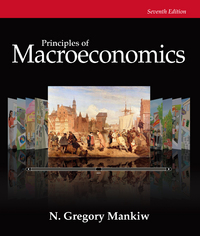Question
1. A food company lowers the price of its food by 5 percent and discovers that the quantity of its product demanded increases by 8
1. A food company lowers the price of its food by 5 percent and discovers that the quantity of its product demanded increases by 8 percent. Evidently the demand for the firm's product is
A. unit elastic.
B. inelastic.
C. elastic.
D. perfectly elastic.
2. As a result of increased production costs, the price of insulin goes up by l0 percent; the quantity of insulin demanded does not change at all. Evidently the demand for insulin is
A. unit elastic.
B. perfectly elastic.
C. perfectly inelastic.
D. relatively elastic.
3. Which one of the following goods is likely to have the leastprice elasticity of demand?
A. Automobiles
B. Vacation travel
C. Prescription drugs
D. Color television sets
4. Which one of the following goods is likely to have the greatestprice elasticity of demand?
A. Salt
B. Aspirin
C. Services of plumbers
D. Skiing equipment
5. Which of the following defines income elasticity of demand?
A. The rate at which quantity demanded changes with a change in price.
B. The rate at which quantity demand changes with a change in income.
C. The rate at which the demand for one good changes as the price of another good changes.
D. The rate at which demand changes with a change in income.
6. A 10% increase in the price of flour causes a 15% decrease in quantity demanded.
The demand for flour is:
A. Perfectly elastic
B. Perfectly inelastic.
C. Unitary elastic.
D. None of the above. (over please)
7. When demand is inelastic and price decreases then
A. total revenue will rise.
B. total revenue will fall.
C. total revenue will be unchanged.
D. total revenue will rise or fall.
8. If an increase in price causes a decrease in total revenue, then the industry is
A. operating on the unitary elastic portion of its demand curve.
B. operating on the elastic portion of its demand curve.
C. operating on the inelastic portion of its demand curve.
D. none of the above possibilities.
9. If the supply of health care is relatively inelastic then a one percent increase in price results in
A. one percent increase in quantity supplied.
B. more than one percent increase in quantity supplied.
C. less than one percent increase in quantity supplied.
D. no change in quantity supplied.
10. If the demand for a product is perfectly inelastic, what happens to price when supply increases?
A. Price increases
B. Price decreases.
C. Price doesn't change.
D. None of the above happens.
Short answer questions
11. An increase in price of a product from $50 to $60 causes a decrease in quantity demanded from 600 units to 500 units. Set up the table and answer
A. what is the price elasticity of demand? 5
B. what that elasticity number is called in word? 1
12.Why is the supply curve with constant unitary elasticity a straight line? 2
13.If you move down along a demand curve to lower prices and higher quantities, what happens to the measured elasticity? 2
Step by Step Solution
There are 3 Steps involved in it
Step: 1

Get Instant Access to Expert-Tailored Solutions
See step-by-step solutions with expert insights and AI powered tools for academic success
Step: 2

Step: 3

Ace Your Homework with AI
Get the answers you need in no time with our AI-driven, step-by-step assistance
Get Started


